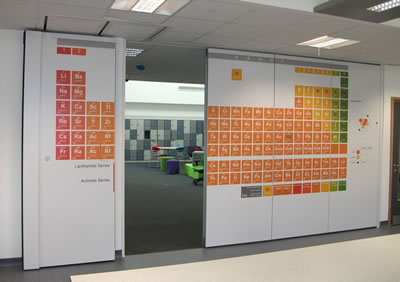Here at Building additions we do business with schools and nurseries on a day to day basis. We are forever fitting educational facilities with folding partitions and operable wall systems; whether they require additional space or sound proofing with acoustic solutions.
You’ll see our team installing moveable walls across many areas of a school from sports halls and canteens to classrooms and stages with the aim of enhancing the existing space and create a flexible working area; for staff and pupils alike.
One thing we notice, particularly in younger years, are the beautifully decorated classrooms, where our walls often become a part of the aesthetics too.
We’ve noticed that many classrooms are a spectrum of colour, with each wall filled with animated characters displaying oversized letters of the alphabet and accompanying images. Numbers from 1 to 20 are usually scattered on the opposite wall encouraging pupils counting skills. Whilst reading corners are filled with images of their favourite book characters, large colourful carpets and cushions; and you are guaranteed to find a wall covered with pupils artwork.
Is it surprising then that recent studies are questioning whether this is perhaps a little distracting?
What is The Bare Wall Theory?
Whilst as adults we can appreciate the colours and aesthetics of a teachers educational masterpiece, for children the story might be a little different.
A recent study, from across the pond at Carnegie Mellon University in Pittsburgh, suggests that a classroom with bare walls is much more beneficial to a child’s learning than previous ideas.
Published earlier this year in Psychological Science it quite simply demonstrated that young children often cope better and respond quicker in a more subdued classroom – frequently scoring better on tests when faced with no visual distractions.
It is important to note that the study followed a group of 24 five and six year olds and therefore the research is no way conclusive.
Anna V. Fisher one of the report’s authors and an associate psychology professor stated that they are now undertaking further research in children ages 5 to 9 as she suspects that what is on the wall becomes less significant as pupils age.
So How Did The Study Work?
The 24 children were taught in 2 simulated classrooms; one had bare walls and the other decorated with an abundance of materials such as presidential photos, science posters and maps along with the children’s artwork.
They took part in six lessons lasting roughly 5 to 7 minutes. In this time the teachers read aloud from picture books. After each session the children were given multiple choice picture tests on topics ranging from the solar system to bugs.
Results showed that pupils in bare walled classrooms were distracted by other students and sometimes even themselves. But as we mentioned already, distraction was significantly more noticeable in children being taught in visually decorated rooms.
Next time you are sat across the desk from your child’s teacher at the latest parents evening, take note of how many times you look around the room – imagine then the difficultly for your child.
Makes sense doesn’t it?
So Can Too Much Visual Stimulation Have A Negative Effect?
Whilst many agree with the latest findings, just as many oppose.
One suggestion is not that the walls should be bare, but instead filled with materials and images pupils have a prior connection too, which avoids distraction. Or alternatively create a more calming classroom, with nature inspired decorations and calming colours.
After all young children need some educational displays to engage them, don’t they?
More Information and Help
If you are interested in optimising space in your classrooms, give us a call today on 01373 454 577 or fill out a contact form here.

